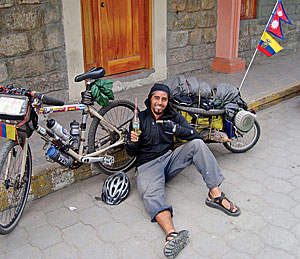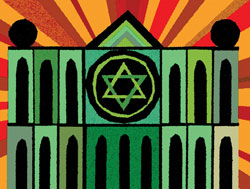sierraclub.org - sierra magazine - may/june 2012 - bulletin: news for members
By Della Watson
Grilled | Synagogue Flips the Switch on Solar
GRILLED
Invading the Privacy of the People Who Make the Club Tick
 Japhy Dhungana
Japhy Dhungana
Name: Japhy Dhungana
Location: Nepal, California, Peru
Contribution: Sierra Club mountaineering, backpacking, and wilderness skills instructor; field studies instructor at Where There Be Dragons
Website: transformundo.com
I read on your website that you did "research" at Burning Man while studying at UCLA.
Well, I studied anthropology. One of my good friends was doing her Ph.D. dissertation on the culture of giving and alternate economies. We live in a market-based system, but at Burning Man they try to dismantle that whole concept.
So you stayed sober while doing that research?
Ummm . . . [Laughs]. But some people do.
You're also a Club mountaineering and backpacking instructor.
Yeah, around 2003 I started instructing for the Los Angeles Chapter's Wilderness Travel Course. We take students out to improve their skills at hiking, navigation, backpacking, snow travel, and rock climbing. I've led a number of trips into the Sierra Nevada, exactly where John Muir was romping around writing his lofty poetry and inspiring folks like you and me to this day.
I want to talk about your bicycle trip from Los Angeles to the tip of South America. Why do you call your bike Bucephalus?
You know, this is one of those things that always strikes me: Folks in the United States inevitably ask me that question. But almost every person in South America or Europe, even children, would immediately say, "Wow, what a cool name—that's Alexander the Great's horse."
So that bike was your way of conquering a continent?
I would say it was more of a love affair: the relationship that one forms with a machine or with an animal like a horse.
You had a love affair with a machine?
Perhaps the most beautiful machine ever invented in the world: the bicycle.
What's the funniest thing that happened to you on that trip?
When I was in Panama, about to cross the isthmus into Colombia, I was frightened. People think of Colombia and see images of narco-trafficking, drugs, guerrilla warfare—a violent place. As I was cycling through, I got stopped by six or seven guys. They surrounded me, poking through my bag, asking me a bunch of questions. Keep in mind, they had huge guns. Then they asked me, "Do you want to join us at camp?" And I thought, "That's it—they're trying to kidnap me. They're going to take me prisoner." But they really were just inviting me to hang out with them, because they'd never seen a cyclist carrying so much equipment and traveling and being kind of a vagabond.
They didn't try to steal anything?
No, they were just curious. In fact, they asked if they could ride my bicycle. I said, "Yeah, gladly, go ahead." They all fell. It's hard to ride a fully loaded bicycle. Then the next question they asked was "Hey man, you want to shoot these guns?" This is the only time in my life I've ever shot a gun.
—interview by Cyndy Patrick
Do you know a Sierra Club volunteer who deserves recognition? Send nominations to submissions.sierra@sierraclub.org.
Synagogue Flips the Switch on Solar
 Greg Mably
Greg Mably
Los Angeles Sierra Club member Jan Freed had a vision: His synagogue, Temple Sinai in Glendale, California, should embrace clean energy and go solar. The temple's board of directors initially balked at the cost, but the former high school environmental science teacher spent two years working to demonstrate that the project was feasible—even going so far as to install panels on his own home. Freed stressed that in addition to being the "right thing to do" to address climate change, the solar panels would save the congregation money.
The temple's new array, which cost $89,000, could save between $200,000 and $900,000 (depending on electricity rates) over 25 years. At the January 29 dedication ceremony, members of the congregation symbolically cut Temple Sinai's electricity bill in half. —Tom Valtin